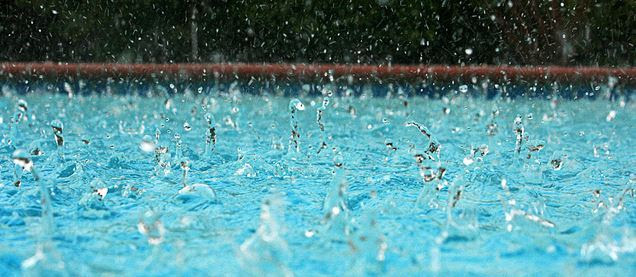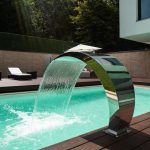RAIN, RAIN, GO AWAY! I WANT TO GET IN MY POOL AND PLAY!
|
Here in the Northeast, weather forecasters have informed us that 20 of the 31 days in May have had some sort of rain. Whether it is light sprinkle or heavy downpours, the rain is affecting us all. It is also affecting our pools and how, and when, we can use them.
WHEN IT RAINS, IT POURS
It sure has been pouring A LOT lately. When we get this amount of rain, it can overflow the pool. When this happens, you want to lower the water level to prevent overflow that can damage pool decking and surrounding landscaping. Ideally, your water level should be about halfway up the skimmers so it can maintain constant surface debris removal. If your water level falls too low below the skimmer, you run the chance of burning out your pump motor (unless you have a functioning equalizer line to protect you!). If the rain has also brought in a lot of leaves and debris that fill up and clog your skimmer baskets, that too can increase the potential for burning out the pump motor. So when this happens, make sure you maintain the proper water level and empty those baskets after it rains. |
 |
|
BLAME IT ON THE RAIN
Additionally, that rain will affect your water chemistry. Fresh water, no matter what the source, will dilute your pool water making it necessary to re-balance your water. This will include calcium hardness and cyanuric acid levels which are both only able to be lowered through dilution. Not surprisingly, the rain here in the Northeast is rather acidic and will also further lower your pH. Your TDS, or total dissolved solid levels, is a measure of all the particulate matter in your pool which may be increased if that rain brings the dirt and debris in with it. So after a rain, you always want to test and rebalance your water. IT’S RAINING CATS AND DOGS
Traditionally, animals don’t fall from the sky, but it can bring out critters like frogs, worms, and bugs during and after it rains. These animals, along with the rain, getting into the pool can contribute to algae growth. Algae are generally classified into three groups which are green, black, and yellow. The green algae is what we typically see growing after a rain storm. Cleaning up the pool as soon as possible and getting rid of all the foreign matter will help to prevent the algae from growing. |
|
I’M JUST GOING TO GET WET ANYWAY
There are some who think it doesn’t matter if it is raining, they can still swim. While it is true that rain won’t make you any wetter while you are in the pool, there are safety issues for which you need to be aware. In the event of an electrical storm (thunderstorm), immediately close the pool at the first sound of thunder or first sighting of lightning. The pool should be cleared and everyone should go inside for safety. Swimming pools are connected to a much larger surface area via underground water pipes, gas lines, electric and telephone wiring, etc. Lightning strikes to the ground anywhere on this metallic network may cause shocks to those in and around the pool area. Bathers should not re-enter the pool until at least 15 minutes after the last sound of thunder or sight of lightning.
Here’s to hoping that these rainy days don’t last too much longer. Until then, it seems like the perfect weather to curl up with a good book. Might we recommend one about swimming pools?
|
Recent Posts





